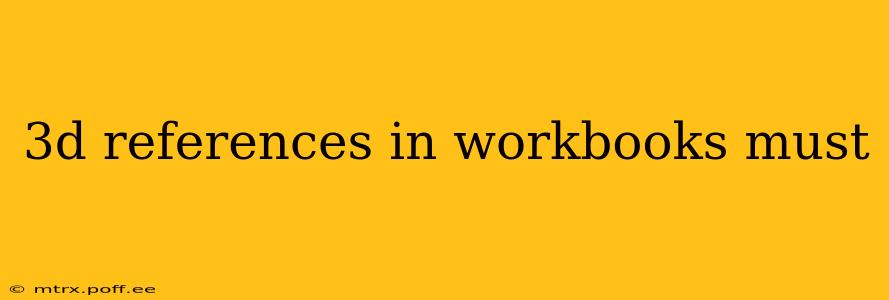3D References in Workbooks: A Comprehensive Guide
Microsoft Excel's 3D referencing capabilities significantly enhance workbook management, especially when dealing with data across multiple sheets. Understanding how to use 3D references effectively is crucial for streamlining complex tasks and improving data analysis. This guide explores the essential aspects of 3D referencing, addressing common questions and offering practical examples.
What are 3D References?
3D references in Excel allow you to refer to the same cell or range of cells across multiple worksheets simultaneously. Instead of individually referencing each sheet (e.g., Sheet1!A1, Sheet2!A1, Sheet3!A1), you can use a 3D reference to encompass them all at once (e.g., Sheet1:Sheet3!A1). This dramatically simplifies formulas and makes your workbooks more manageable.
How to Use 3D References
Creating a 3D reference is straightforward:
-
Identify the range of sheets: Determine the starting and ending sheets you want to include in your reference. For example, if you want to include data from
Sheet1toSheet5, your range isSheet1:Sheet5. -
Specify the cell or range: After the sheet range, add an exclamation mark (!) followed by the cell or range reference. For instance, to refer to cell A1 on all sheets from Sheet1 to Sheet5, you would use
Sheet1:Sheet5!A1. To sum the values in A1 to A10 across these sheets, you'd useSUM(Sheet1:Sheet5!A1:A10). -
Apply the formula: Use the 3D reference within your desired formula. Many functions work seamlessly with 3D references, including
SUM,AVERAGE,MAX,MIN,COUNT, and more.
Example:
Let's say you have monthly sales data for January through December on separate worksheets, each named after the month. To calculate the total sales for Product X across all months, you could use a 3D reference like this: =SUM(January:December!B10) (assuming B10 contains the sales figure for Product X on each sheet).
What are the limitations of 3D references?
While powerful, 3D references have limitations:
-
Sheet Order Matters: The order of sheets within the workbook affects the 3D reference. If you insert or delete sheets within the referenced range, the formula needs to be updated.
-
Not all functions are compatible: Some more advanced functions may not work directly with 3D references. In such cases, you might need to use alternative techniques like array formulas.
-
Performance: Using 3D references on a very large workbook with numerous sheets can impact performance. For extremely large datasets, consider other data manipulation methods.
How do I sum values across multiple sheets using 3D references?
Summing values across multiple sheets using 3D references is straightforward. Simply use the SUM function with your 3D range: =SUM(Sheet1:Sheet10!A1) sums cell A1 across sheets 1 through 10. For a range of cells, use =SUM(Sheet1:Sheet10!A1:B5).
Can I use 3D references with other functions besides SUM?
Yes, many other functions work well with 3D references, including AVERAGE, MAX, MIN, COUNT, COUNTA, and others that operate on ranges of data. For example, =AVERAGE(Sheet1:Sheet5!B1:B10) calculates the average of cells B1:B10 across sheets 1 through 5.
What are some best practices for using 3D references?
-
Clear Naming Conventions: Use descriptive sheet names to improve readability and understanding of your 3D references.
-
Regular Auditing: Periodically review and test your formulas, especially after inserting or deleting sheets, to ensure accuracy.
-
Consider Alternatives: For very large workbooks, explore other methods like PivotTables or Power Query for better performance.
By mastering 3D references, you can significantly improve your efficiency in working with multi-sheet Excel workbooks, allowing for more sophisticated data analysis and reporting. Remember to utilize best practices to maintain accuracy and workbook performance.
